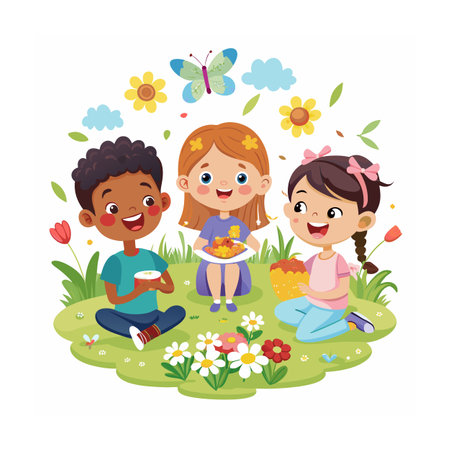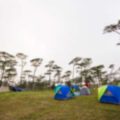Introduction to Campfire Cooking with Kids
There’s something truly magical about gathering around a crackling campfire in the heart of the British countryside. Introducing children to campfire cooking is more than just preparing meals outdoors—it’s about nurturing a sense of adventure, teamwork, and self-sufficiency. Whether you’re exploring the Lake District, pitching up in the Scottish Highlands, or enjoying a weekend staycation at your local campsite, campfire cooking offers families a wonderful opportunity to bond and make lasting memories. By involving kids in planning, prepping, and cooking meals over an open flame, you’re not only teaching them essential life skills but also encouraging curiosity and respect for nature. The experience is full of laughter, learning, and a little bit of mess—perfect ingredients for any family outing in the wild UK landscape.
Campfire Safety for Families
Ensuring a safe and enjoyable campfire experience is vital when camping with children. British families must be aware of local fire regulations, proper campfire setups, and the importance of educating children on responsible behaviour around an open flame. Here’s what you need to know:
Understanding UK Fire Regulations
Before heading out, always check the rules for campfires in your chosen location. Many sites across the UK have specific guidelines or restrictions, especially during dry spells or in areas of special environmental protection. Most campsites will display their fire policy on their website or at reception, so make sure you’re up to date.
Setting Up a Safe Campfire
A well-chosen spot and careful setup are key to preventing accidents. Follow this checklist for a safe campfire arrangement:
| Step | What to Do | Why It Matters |
|---|---|---|
| 1. Choose the Right Spot | Pick a flat, clear area away from tents, trees, and flammable materials. | Reduces risk of fire spreading. |
| 2. Use Designated Fire Pits | If available, always use provided fire pits or rings. | Keeps fire contained and manageable. |
| 3. Prepare the Area | Clear leaves and debris within a two-metre radius around your fire site. | Prevents accidental ignition of surroundings. |
| 4. Keep Water Nearby | Have a bucket of water or sand ready before lighting your fire. | Allows for quick extinguishing if needed. |
| 5. Supervise Constantly | An adult should monitor the fire at all times—never leave it unattended. | Children can be unpredictable; supervision prevents mishaps. |
Teaching Children Campfire Safety
Involving kids safely builds confidence and respect for the outdoors. Here are some practical tips:
- Create Clear Boundaries: Use sticks or stones to mark a ‘no-go’ zone around the fire—explain its purpose to your children.
- Demonstrate Safe Movements: Show children how to move around the fire (walk, never run), and explain why loose clothing should be avoided.
- No Playing Near Flames: Make it clear that games and rough play are not allowed near the campfire area.
- Fire Safety Drills: Teach children what to do if something catches alight—‘Stop, Drop & Roll’ is simple and memorable.
- Learner’s Involvement: Let older children help with tasks like fetching water or placing kindling under close supervision; it keeps them engaged while reinforcing rules.
A Quick Reference: Campfire Safety Dos & Don’ts for Kids
| Do | Don’t |
|---|---|
| Sit calmly with adults by the fire. | Toss objects into the flames. |
| Ask before approaching the fire. | Poke or prod the fire with sticks unsupervised. |
| Wear close-fitting clothes and tie back long hair. | Run or play near the campfire area. |
| Help extinguish the fire properly when finished. | Leave rubbish or food scraps in the fire pit. |
A thoughtful approach to campfire safety ensures everyone can enjoy outdoor cooking in true British style—cosy evenings, toasted marshmallows, and peace of mind all round!

3. Planning Your Wild Cooking Experience
Choosing the Right Campsite in the UK
The first step to a successful campfire cooking adventure with kids is picking a suitable campsite. Across the UK, there are plenty of family-friendly campsites that welcome campfires. Look for sites with dedicated fire pits, clear rules on open flames, and easy access to fresh water. Popular spots in the Lake District, Yorkshire Dales, or Cornwall often offer excellent facilities for families. When booking, check if the site allows wood gathering or if you need to bring your own sustainable fuel sources.
Preparing Your Essential Kit
For stress-free wild cooking, preparation is key. Start by packing a lightweight but sturdy cooking kit: think portable grill racks, fireproof gloves, long-handled utensils, and marshmallow skewers. Don’t forget reusable plates and cutlery, a washing-up tub, and eco-friendly soap. For safety, include a first-aid kit, a bucket for water or sand to extinguish fires, and a torch or headlamp for those late evening meals. Pre-portioning ingredients at home can save time and reduce mess at the campsite.
Making a Simple Checklist
A checklist ensures nothing crucial gets left behind. Here’s an easy example:
- Tent and sleeping bags
- Fire lighting tools (matches/lighter/firelighters)
- Cooking equipment (grill rack, pots, pans)
- Food prepped and packed
- Water bottles and extra drinking water
- First aid kit
- Wet wipes/hand sanitiser
- Rubbish bags for cleaning up
- Sustainable fuel (wood/charcoal as permitted)
- Torch/headlamp with spare batteries
Having this list at hand will keep your trip organised and enjoyable, letting you focus on fun and flavour around the campfire.
4. Family-Friendly Campfire Recipes
Cooking over a campfire with kids is a wonderful way to introduce them to the joys of the outdoors and British culinary traditions. With a bit of planning, you can whip up simple, hearty meals that children love, all while using locally sourced ingredients and classic campfire techniques. Here are some kid-approved recipes with a British twist that are perfect for your next adventure in the wild.
Easy British Campfire Favourites
| Recipe | Main Ingredients | Why Kids Love It | Campfire Cooking Method |
|---|---|---|---|
| Bangers in a Bun | Cumberland sausages, soft rolls, caramelised onions | Tasty, familiar, easy to eat with hands | Grill sausages on skewers or grill grate over hot coals |
| Campfire Jacket Potatoes | Maris Piper potatoes, butter, grated cheddar, baked beans | Customisable toppings, crispy skin, fluffy inside | Wrap in foil and bake directly in embers |
| Toasted Marshmallow & Digestive S’mores | Digestive biscuits, milk chocolate squares, marshmallows | Sweet treat with a British biscuit twist | Toast marshmallows on sticks over flames, sandwich between biscuits and chocolate |
| Cheesy Veggie Foil Parcels | Carrots, peas, potatoes, red Leicester cheese, herbs | Colourful veggies and melty cheese appeal to picky eaters | Chop veggies and cheese into foil parcels; cook in hot embers for 20 minutes |
| Porridge Pots with Berries & Honey | Porridge oats, local berries (blackberries or raspberries), honey or golden syrup | Warm breakfast thats healthy and filling; fun to customise toppings | Cook oats in a billy can or small pot over fire; stir in berries and honey before serving |
Clever Tips for Stress-Free Campfire Cooking with Kids
- Get Children Involved: Let them help wrap potatoes or assemble s’mores—simple tasks make them feel part of the adventure.
- Pre-Prep at Home: Slice veggies or pre-mix porridge oats before you head out for easier assembly around the campfire.
- Use Local Ingredients: Visit farm shops or local markets near your campsite for fresh produce and regional specialities—this supports local communities and adds an authentic touch.
- Simplify Cleanup: Foil parcels minimise washing up and keep things tidy—perfect for families on the go.
A Taste of Adventure with Every Bite
The best campfire meals combine ease of preparation with delicious flavours and fun participation from everyone. By putting a British spin on classic campfire favourites and using ingredients from the area you’re exploring, you’ll create lasting memories—and maybe even inspire little ones to become outdoor cooks themselves!
5. Getting the Kids Involved
One of the greatest joys of campfire cooking with kids is watching them embrace new skills and grow in confidence. Encouraging your children to participate not only makes the experience more enjoyable for the whole family, but also turns mealtimes into valuable learning opportunities.
Creative Ways to Get Kids Stuck In
Start by assigning age-appropriate tasks. Little ones can help wash veg, gather kindling, or set out utensils, while older kids might try their hand at skewering kebabs or mixing pancake batter. Make a game out of ingredient spotting or challenge them to build the most colourful sandwich. Letting children choose recipes from a shortlist can also give them a sense of ownership and excitement about what they’re making.
Teaching Safety Through Hands-On Experience
Supervise carefully, but don’t be afraid to let kids get involved with some real cooking jobs under close watch. Show them how to handle tools safely, explain why we keep water nearby, and demonstrate how to stay clear of the flames. Use simple, memorable phrases like “always point handles away” or “one person at the fire at a time” to reinforce good habits.
Making Clean-Up Fun
Turn tidying into a team effort—who can pick up the most bits of rubbish, or who’s the fastest at packing away plates? Sing a favourite song as you wash up together or invent a points system for each task completed. This not only helps keep your campsite safe and tidy but also teaches responsibility and teamwork in a fun, relaxed setting.
By involving kids every step of the way—from chopping and stirring to serving and scrubbing—you’ll create lasting memories and foster a love of outdoor cooking that will stick with them for life.
6. Practical Tips for All-Weather Cooking
Let’s face it: British weather is famously unpredictable, but that shouldn’t put a dampener on your family campfire cooking adventures. With a bit of savvy prep and the right kit, you can whip up delicious meals with your kids come rain or shine.
Sheltering Your Cooking Spot
A simple tarpaulin is a lifesaver—set it up between trees to create a makeshift canopy, keeping your fire and food dry without trapping smoke. Pop-up gazebos or even an old golfing umbrella can also do the trick in a pinch. Always check site rules about open flames under cover, and keep shelter high enough for ventilation.
Keeping Food Safe and Tasty
Cool Bags & Insulated Boxes
Invest in sturdy cool bags or insulated boxes for perishables. Pack them with plenty of reusable ice packs and keep them shaded. In colder months, use thermal flasks to keep soups or stews piping hot for hours—great for quick lunches after a chilly walk.
Smart Packing & Prepping
Pre-chop veg, marinate meats, and portion snacks before you head out. This reduces faff at camp and keeps little hands from handling raw ingredients too much when it’s muddy or wet.
Clever Cooking in the Rain
- Opt for foil-wrapped meals: They cook evenly on embers and stay protected from drizzle.
- Bring waterproof matches or a windproof lighter—crucial for getting your fire going on soggy days.
- Have a backup stove: A small camping gas stove makes sure you can still enjoy a cuppa or hot chocolate if the wood’s too damp to catch.
Family Morale Boosters
Nothing beats the mood like warm, hearty food after a spell of drizzle! Keep spirits high by involving kids in choosing recipes and setting up your weather-proof kitchen. Embrace the elements—after all, muddy boots and rosy cheeks are part of the adventure!

